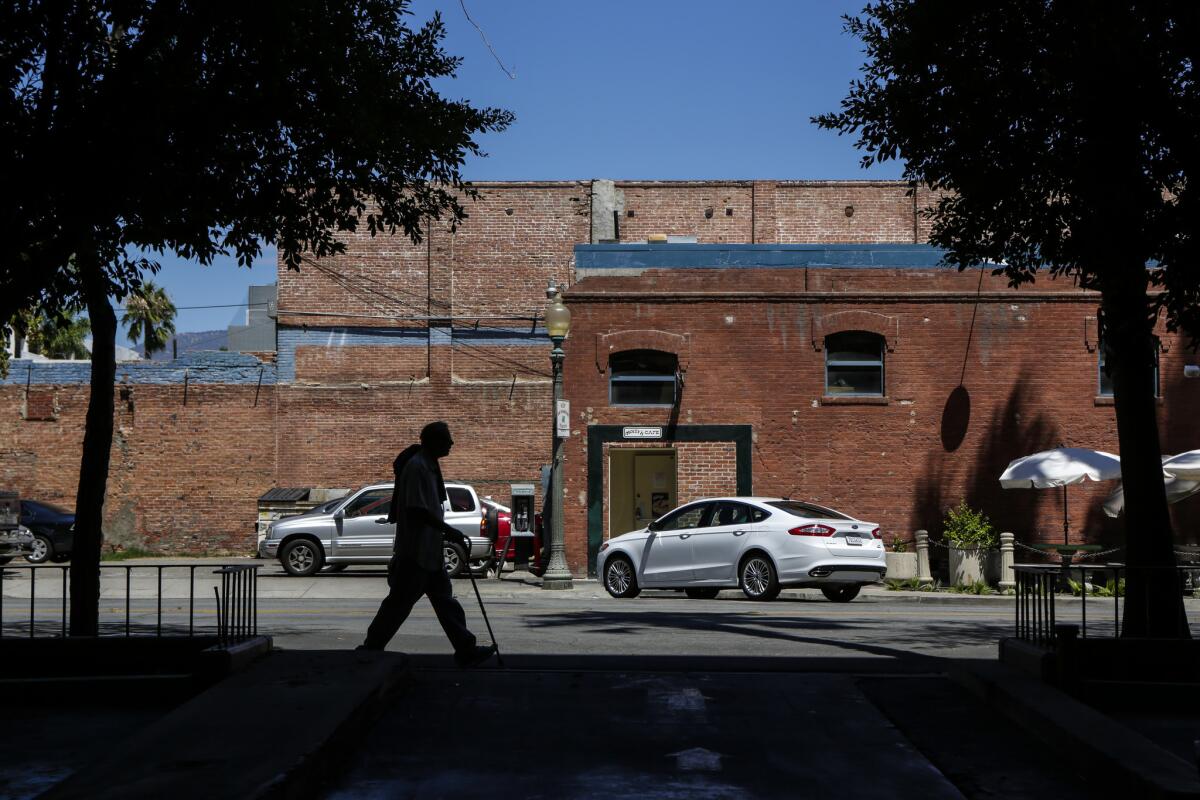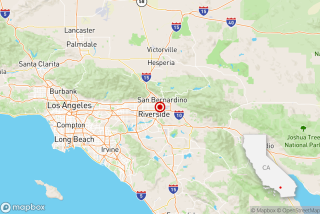Thousands of California’s brick buildings face quake danger

Three decades after some California cities began requiring old brick buildings to be seismically retrofitted, thousands across the state still have not been strengthened and are in danger of collapse during a major earthquake.
Many are in some of California’s poorest cities, where officials have chosen not to require property owners to make the upgrades.
Seismic experts are particularly worried about communities in western San Bernardino County, which are threatened by the San Andreas and San Jacinto faults.
The city of San Bernardino, which is in bankruptcy, has one of the largest concentration of unreinforced masonry buildings in the state that are at risk of particularly intense ground motion, U.S. Geological Survey seismologist Lucy Jones said.
“This is not a question of ‘Maybe these buildings will come down,’ they absolutely will come down,” she said.
About 70% of the 26,000 brick buildings across California have been retrofitted or demolished, with major cities such as San Francisco and Los Angeles requiring action, according to the most recently collected data published by the California Seismic Safety Commission.
Even smaller towns such as Napa have mandatory rules, which experts credited with preventing widespread destruction during Sunday’s 6.0 earthquake. Although damage still occurred in Napa, no retrofitted buildings collapsed.
As many as 8,000 remaining brick buildings are at risk of collapse, according to the data published by the state in 2006. The number probably has not changed significantly since, commission Executive Director Richard McCarthy said.
According to records and interviews, San Bernardino, Ontario and Bakersfield are among the cities that have no mandatory rules on retrofitting brick buildings.
Bakersfield had a retrofitting law from 1993 to 1997 that allowed the city to seize and demolish brick buildings that were not retrofitted, and 125 out of 150 buildings were strengthened.
But city officials rescinded the ordinance after property owners complained about the expense. Since then, only three of the remaining 25 have been retrofitted.
“I’m surprised it lasted four years,” said Phil Burns, Bakersfield’s building director. “But it was pretty successful.”
San Bernardino’s mandatory retrofitting law lasted only a short time before it was rescinded in 1999. Only 15 of about 130 brick structures have been retrofitted there.
City staff has been trying to come up with a plan to reduce the threat from these buildings, but any proposal would fall short of mandatory retrofitting, building director Mark Persico said.
The plan will propose what’s “best given the economic realities of San Bernardino,” he said.
Retrofitting can cost property owners tens of thousands to hundreds of thousands of dollars depending on size and complexity of the job. Many owners say they can’t afford the expense.
Molly’s Cafe in downtown San Bernardino is in an unreinforced building on historic Route 66. Restaurant owner Antonio Canul, 51, said the brick exterior is one of its draws, and he wouldn’t want to tinker with the building.
“Lots of people know it by the way it is,” Canul said. “I’m not going to fix something that’s not broke. I’m going to leave everything the way it is.”
Some residents say that it would be tough for San Bernardino to require retrofiting in such an economically struggling area with one of the highest poverty rates among the country’s largest urban areas.
In Ontario, officials believe just one of 40 brick buildings has been retrofitted. But high retrofitting costs and a lack of damage from previous quakes has blunted a sense of urgency, building official Kevin Shear said.
“I’ve lived in California, born and raised here, over 55 years and always heard the Big One’s coming,” Shear said. “I mean, it’s going to happen. But the damage will depend on the type of earthquake.”
Owners may feel it’s worth the gamble, the USGS’ Jones said, “but the cost of not retrofitting falls on all of us.”
“The owner loses his building,” she said. “The tenants lose a place to go to work -- sometimes they lose their lives. Communities lose those businesses. And they lose the businesses in adjoining buildings.”
Unlike modern buildings with frames, brick buildings have no skeleton. So the only thing keeping the structure upright is the mortar between the bricks.
But the mortar can essentially be ground into sand when shaken in an earthquake. Bricks start being ejected from the upper walls, and the roof can come crashing down.
The basic retrofitting involves pushing steel rods to affix the brick wall to the building’s ceilings and floors. More extensive retrofittings involve installing diagonal braces or adding reinforced concrete or polymers to the walls.
The problem with brick buildings was clear during the 1933 Long Beach earthquake: structures were left in rubble; bricks shot across the street like cannonballs.
Los Angeles was one of the first cities in California to require brick retrofitting; out of about 8,000 buildings, all but three have been retrofitted or demolished after a 1981 law. In some cases, Los Angeles officials had to go to court and threaten to label a building as unsafe, barring anyone from being inside it.
As a result of the retrofitting, no one died from brick building damage in the 1994 Northridge earthquake.
Subsequent earthquakes got other cities into action. San Francisco passed a mandatory ordinance after the 1989 Loma Prieta earthquake, when five commuters lost their lives when a brick wall fell. So did San Luis Obispo after the deadly 2003 Central California earthquake. Out of 126 brick buildings, only 14 still need work.
Some owners decided to sell to avoid the law. But as a result of retrofitting and related renovations, “the byproduct has been a complete renaissance of our downtown,” said Derek Johnson, San Luis Obispo’s community development director.
The recession has interrupted progress in other cities. Oakland suspended enforcement in 2009 but is now renewing its efforts. One issue: some owners are opting to pay fines of $15,000 rather than get the retrofitting done, building official Deborah Sandercock said.
Those fines are cheaper than retrofitting.
Strengthening buildings doesn’t mean a big quake won’t cause damage. But it will give those inside a fighting chance, officials say.
“The retrofit is designed for the building to stay up long enough for people to get out of it,” said Luke Zamperini, chief inspector for the Los Angeles Department of Building and Safety.
hector.becerra@latimes.com
james.barragan@latimes.com
ron.lin@latimes.com
Follow us on Twitter: @hbecerralatimes @James_Barragan @ronlin
More to Read
Start your day right
Sign up for Essential California for news, features and recommendations from the L.A. Times and beyond in your inbox six days a week.
You may occasionally receive promotional content from the Los Angeles Times.









